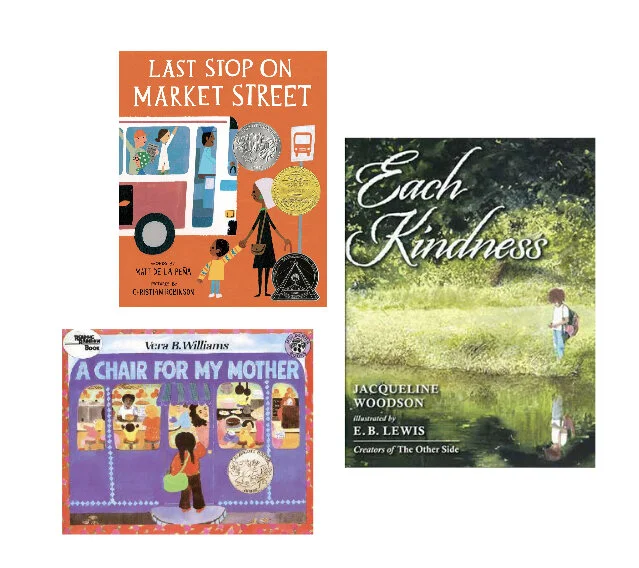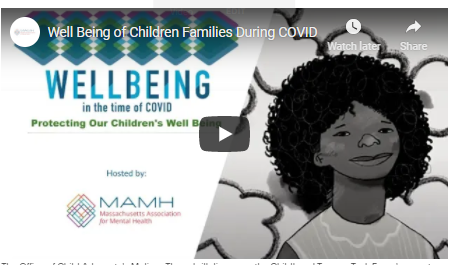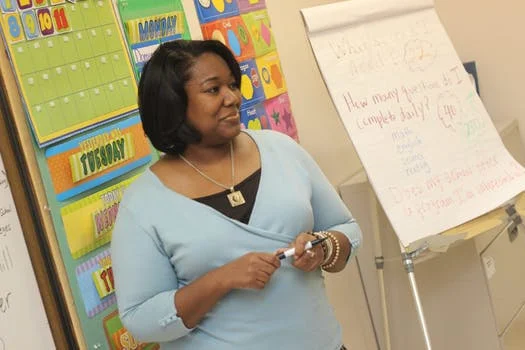Critical Analysis of Socioeconomic Diversity in Children’s Literature by Vanessa Niro
Introduction:
Over the past decade, there has been a widespread movement for children’s
literature to become more diverse. Research shows the importance of children being
able to see themselves in the characters and have their identities be represented in
stories. However, there are surprisingly few quality books that show socioeconomic
diversity. For this analysis, I have intentionally chosen three children’s books that have
characters from a lower class or impoverished background. Utilizing readings that we
have been looking at in class, I will analyze each book and determine whether it is high
quality children’s literature that can be used as a resource by teachers and caregivers
who are trying to implement a class-conscious approach in their classrooms-- which is
an essential, yet often overlooked, aspect of teachers’ cultural competence.
Individual Analyses for Books:
1. Last Stop on Market Street
Critical Children’s Literature Analysis 2
Written by Matt De La Peña, illustrated by Christian Robinson
2015
Penguin Books; New York City
3-8 years old
Caldecott Honor, Newbery Medal, Coretta Scott King Illustrator Honor
Synopsis:
This book tells the story of CJ and his grandmother and their journey, from
church to a soup kitchen. They use public transit (a city bus) and walking to get there.
Along the way, CJ seems unhappy about having to go on this trip and questions his
grandmother about a variety of things he notices that they do not have-- for example,
wondering why they don’t have a car or an MP3 player. She always has a response
ready, such as reminding him that they get to ride a bus that “breathes fire” with a driver
who does magic tricks for him, or that they get to listen to real, live music from guitar
player on the bus. By the time they reach the soup kitchen, CJ’s questions cease and
he states to his grandmother that he is glad that they came.
Analysis - Text Quality:
The text contains a very powerful and valuable theme-- that there is always a
way to see the beauty in hardship. Some may critique this as being an insensitive way
to view economic hardship. After all, it is easy to tell someone who is struggling
financially that money does not matter and it is not necessary for happiness, when in
Critical Children’s Literature Analysis 3
reality, it is does matter and is necessary for survival in a capitalist society. However, I
do not think this particular story has that connotation. If anything, CJ’s grandmother
recognizes and legitimizes his qualms with not having money and not being able to
purchase luxuries, but also helps him see value in small instances of joy in his daily life
and routine. He begins to understand this when he muses that “his nana always found
beautiful where he never even thought to look”. The text alone is not what makes this
the rich, powerful book that it is-- the bright, unique illustration create transmediation
which is “an artful, synergistic blending of text and illustration in which the meaning from
the text and the illustrations are interconnected so that the whole is greater than the
sum of its parts” (Hoffman, Teale, & Yokota, 2015, p. 12-13). The illustrations also have
an almost child-like quality to them which further contributes to the bright, positive
theme.
Analysis - Self Image and Audience:
One important aspect of this book that contributes to self image is that it depicts
a diverse range of people. Black, white, Latinx, and people of varying abilities are
shown both on the city bus and in the soup kitchen, which sends a clear message that
people of all different identities can and are struggling in the world. All of these people,
especially in the last scene of the soup kitchen, are shown with smiles on their faces
and conversing with people at their table. This fosters a sense of community, which is
an important aspect of getting through any hardship. Some may argue that this view of
poverty is through rose-tinted glasses-- I disagree because the hardships are still very
Critical Children’s Literature Analysis 4
much portrayed, such as needing to go to the pantry for food or not being able to afford
certain luxuries, but the way it is depicted in this book avoids victimizing those who are
living in poverty. Instead, it is a humanized view that not only validates children who can
relate to CJ on a class level, but also makes it easy for children of middle or upper
economic classes to still be able to relate to the story. This book is heartwarming,
interesting, and facilitates a lot of dialogue with children about things they find beauty
and gratitude in, and creates a safe space for them to explore their own feelings about
financial struggles their families may be going through.
Analysis - Authenticity and Language:
The language within this book is quite rich and diverse. Descriptive language is
used on every page, like when the feeling of music is described as “sunset colors
swirling over crashing waves” and higher level vocabulary such as “freedom”. Some of
the dialogue, mostly when the grandmother is speaking, is in African-American
vernacular. Along with the richness of the text, this shows readers that AAVE is a
valuable acceptable form of dialect, which goes against much of the white-centric ideals
embedded particularly in academics and education in this country that this is an
incorrect or illiterate way of speaking. The authenticity of the author is something to
consider as well because “even as the number of diverse books increases substantially,
the number of books written by people of color still has not kept pace. Not much has
changed since last year when Black, Latinx, and Native authors combined wrote just 6%
of new children’s books published. This year the number is only 7%” (Corrie, 2018)
Critical Children’s Literature Analysis 5
While it is unclear about the author’s economic background as a child, Matt De La Peña
is a Mexican-American man who has written a variety of books about his personal
experiences with race and ethnicity. So it may be uncertain how much personal
experience he has had with financial struggles, it is inarguably important that we make
an effort to add more literature to our classrooms that come from authors with diverse
backgrounds such as himself.
2. A Chair For My Mother
Written and illustrated by Vera Williams
1982
Greenwillow Books; New York City
3-8 years old
Caldecott Medal
Synopsis:
This book follows the story of a young girl whose family, consisting of her
grandma and mother, had to move into her aunt and uncle’s downstairs because of a
fire that destroyed nearly everything they owned. Her mother works at a diner, which
she often will help out at. They have a jar at home and each night, they put coins and
tips into it. Once the jar is full, they plan to use it to buy a chair, which her mother is
especially looking forward to because she does not have a comfortable place to rest
Critical Children’s Literature Analysis 6
after being on her feet for long hours at the diner. When they do go shopping for one,
her family goes together to pick out the perfect chair and the book ends with her mother
resting on the new chair with her snuggled up in her lap.
Analysis - Text Quality:
My main critique is that the sequencing of the story may be hard for young
children, especially preschool-aged children to grasp because it jumps back in time to
explain the fire. The concepts of past and future are quite abstract and challenging for
young children to fully understand. I did find the physical representation of money in the
jar to be very developmentally appropriate for preschoolers. It takes a fairly abstract
concept (the value of money) and displays it in a more concrete way for them to
understand. I also enjoyed the people portrayed in positions of power. For example,
Josephine is the protagonist's mother’s boss and is also a Black woman. Also, the main
breadwinner in the protagonist’s family is the mother.
Analysis - Self Image and Audience:
People of color are often disproportionately affected by homelessness,
displacement, and housing discrimination. Many cases of fires in people’s apartments
can be blamed on poor upkeep by the landlords and there is a long history of the links
between race/ ethnicity and safe, clean housing. So while we should have literature and
conversations that address this issue, I think it is important to also have stories of
displacement and homelessness with white protagonists to avoid there being a
Critical Children’s Literature Analysis 7
misconception, especially amongst students from a more privileged upbringing, that
people of color are always impoverished and suffering. This story also lends itself to
children practicing their fictional selves, which is “the ability to place ourselves right in
the centre of a story is a valuable start to becoming a reader or writer” (Whitehead,
2010, p. 109). By having a non-traditional family model (a mother and grandmother as
the primary caregivers), many more children may be able to connect themselves to the
characters in this book. Furthermore, most children have one or two caregivers often
working long hours, which is represented in this story as well. It can be difficult being
away from their primary caregivers for the majority of the day, and this story does a nice
job at explaining why many families have to do this.
Analysis - Authenticity and Language:
The language itself in this book is rather simple and there are little higher level
vocabulary words, and fairly simple descriptive phrases. That being said, I believe the
simpleness of the language makes it more accessible to children, especially since it is a
slightly longer book with a bit more complicated way of sequencing/ plot line. Upon
further research on Vera Williams’ Wikipedia page, her father was absent for much of
her childhood and she spent many of her years teaching in inner-city and alternative
schools. So while she may not have personal experience with losing a home, aspects of
her personal experiences shine through the text in an authentic way, such as not having
an available father figure and living and working in cities.
Critical Children’s Literature Analysis 8
3. Each Kindness
Written by Jacqueline Woodson, illustrated by E. B. Lewis
2012
Penguin Putnam Inc.; New York City
4-8 years old
Coretta Scott King Honor, Jane Addams Peace Award
Synopsis:
In this book, a girl named Chloe reflects on the time that a new child started to
attend her school. This new child, Maya, came to school in noticeably ragged, old
clothing. Chloe’s peers exclude Maya and often whisper hurtful things about the state of
her clothing and what they perceive as her being “dirty” or poor. Chloe chooses to
remain quiet and follow the lead of her peers in excluding Maya. One day, the teacher
does a lesson with the children where each child dropped a stone into a bowl of water,
while telling their peers of a time they did something kind. It was explained that each
time a person does something kind, it goes out like a ripple into the world. When it came
time for Chloe’s turn, she could not think of a kindness she had done and chose to pass
it on to the next child. Sometime after this, the teacher tells the class that Maya would
not be coming back to school because her family had to move. On her walk home,
Chloe reflects on the chance she had be kind to Maya, which was represented in the
rock she tossed into the pond, and watched the ripples fade away-- much like her
chance to be kind to Maya had faded away.
Critical Children’s Literature Analysis 9
Analysis - Text Quality:
This story is fairly heavy on text, which leads it to be a better choice for older
preschoolers, but the language used is still accessible to young children. While the
theme of kindness and the effects of social exclusion are a bit abstract and complicated
to explain to children, this story offers an excellent way to do it in a more concrete
manner. The analogy of the stone in water, with the ripples being kindness, may seem
deeply philosophical but young children can certainly grasp the meaning behind it,
especially with the story as an aid. The illustrations really tie the story together--
beautiful, watercolor paintings show facial expressions and emotions very clearly and
also depict a culturally diverse cast of children, with the main character being a young,
Black girl. Socioeconomic diversity is also a huge theme, and this story shows the ways
children of different classes can still relate and have the potential of friendships with one
another (ie; Maya likes playing the same games as the other girls). Some people may
argue that this story sends the wrong message to children since the main characters
refused to look past Maya’s secondhand clothing, but I believe that with intentional
dialogue, teachers can avoid children coming to that conclusion.
This is easily one of the most sophisticated and beautiful examples of character
development that I have seen in children’s literature as well. Chloe is an impressive
example of a round character, which are characters defined as “dynamic, changing, and
malleable... In other words, round characters are like real people—they act, think, and
speak differently depending on the immediate context” (Hoffman, Teale, & Yokota,
Critical Children’s Literature Analysis 10
2015, p. 12). She is not labeled as a bully or a victim, or as good or bad, she is a person
who has made decisions that she realizes were not kind and is now reflecting on them.
Analysis - Self Image and Audience:
Building on the former remarks about Chloe’s character development, this book
is very easy for children to see themselves in. Relational aggression and exclusion
begins as young as preschool as children are trying to explore power dynamics, and
most children will find themselves as perpetrators or victims of it at some point. Another
aspect of this developmental stage is that they are creating schemas to help make
sense of the world around them, which is why they often label people as good or bad,
and enjoy playing superheroes and villains. This story scaffolds children in this stage to
begin to see outside of those boxes, and recognize that people are not necessarily good
or bad, but that everyone is capable of acting kind or unkind, and that people are able to
change if they reflect on how their actions affect others. This story may be utilized as a
way to support children while they social problem solve and generate conversation
around questions such as how does it make you feel when someone excludes you?
What are ways you can tell someone you don’t feel like playing with them while still
being kind? How are you different from some of your friends? How are you the same?
Analysis - Authenticity and Language:
Jacqueline Woodson is an important children’s literature author in many circles of
educators that are committed to social justice. She is a Black woman and has personal
Critical Children’s Literature Analysis 11
experience with many of the injustices she writes about. It is likely that her own
experiences influenced the way she wrote about the difficult experience Chloe has as
she tries to navigate trying to fit in with her peers and morality because it is something
that most people, but especially women, experienced as a child due to the
pervasiveness of relational aggression and social exclusion with young girls (which is
tied to the gendered way we raise children).
Conclusion:
While all books have some critiques and shortcomings to them, Last Stop on
Market Street, A Chair For My Mother, and Each Kindness should be revered as high
quality children’s books that should have a place on the bookshelves of early childhood
classrooms. The themes of economic diversity, cultural and socioeconomic
representation, and the importance of community are highlighted in all three books and,
in my opinion, transcend any deficits they exhibit. Furthermore, these examples of
literature show an authentic representation of poverty and financial hardships without an
air of white saviorism or victimization. As teachers who make an effort to progress and
improve our class-conscious practices within our classrooms, it is vital to constantly
critique the literature we are providing for our children to make sure it is representative,
engaging, authentic, and able to create a safe space for children to engage in rich, raw
dialogue about personal experiences and hardships.
References:
Critical Children’s Literature Analysis 12
Corrie, Jalissa (2018). The Diversity Gap in Children's Book Publishing. Retrieved from
https://blog.leeandlow.com/2018/05/10/the-diversity-gap-in-childrens-book-
publishing-2018/
Hoffman, J.L., Teale, W.H., Yokota, J. (2015). The Book Matters! Choosing Complex
Narrative Texts to Support Literary Discussion. Young Children, 8-15.
Whitehead, Marian. (2010). Chapter 6: Narrative and Storying. Language and Literacy
in the Early Years 0-7. 103-117




